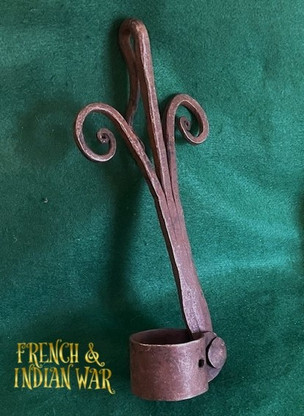 Loading... Please wait...
Loading... Please wait...-
Call us on (973) 810-2976
- My Account
- Gift Certificates
- Items / $0.00
All prices are in All prices are in USD
Categories
- Home
- Sold, Hold, Layaway items
- RARE – French & Indian War Hanging Shackle, ca. 1758, recovered at Fort Carillon (ON HOLD,M)
RARE – French & Indian War Hanging Shackle, ca. 1758, recovered at Fort Carillon (ON HOLD,M)
Out of Stock
Product Description
This is a very early hand-forged hanging prisoner shackle, ca. 1758. It measures 16 ½” x 6 ¼” and the foot/wrist band has a diameter of 2 ¾”. The hideous design of this shackle was not only to contain a prisoner but also act as a form of punishment.
The iron band would be put around the ankle and tightened with a heavy bolt, then hung off of a chain or bar which would prevent the prisoner from getting loose. It was most likely French because of the design of the “fleur de lis“ by the blacksmith (see pictures).
It could also be used on the smaller wrist by putting a bolt through the two holes on the band. It was recovered from the French lines in front of Fort Carillion (present day Fort Ticonderoga).
The Battle of Carillon, also known as the 1758 Battle of Ticonderoga, was fought on July 8, 1758, during the French and Indian War. It was fought near Fort Carillon on the shore of Lake Champlain in the frontier area between the British colony of New York and the French colony of New France.
In the battle, which took place primarily on a rise about three-quarters of a mile from the fort itself, a French army of about 3,600 men under General Marquis de Montcalm and the Chevalier de Levis defeated a numerically superior force of British troops under General James Abercrombie.
The frontal assault on an entrenched French position without using field artillery, a lack that left the British and their allies vulnerable and allowed the French to win a complete victory. The battle was the bloodiest of the American theater of the war, with over 3,000 casualties suffered. French losses were about 400, while more than 2,000 were British.
This is a very solid piece and actually quite rare. I am sure that there may be more, but I am unaware of any other examples. I spoke with an expert on these type of early restraints and he told me he had seen similar examples, but being hand-forged there would not be two identical.



